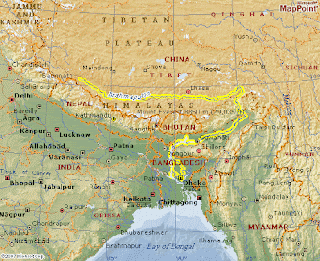By Amit Ranjan
 |
| Amit Ranjan |
Amit Ranjan is a Research Scholar in South Asian Studies division of School of International Studies, Jawaharlal Nehru University, New Delhi. This is his fourth posts on this blog. He can be reached at amitranjan.jnu@gmail.com.
There is growing concern in India over the country’s water security given China’s geographic chokehold on almost every important river system in South Asia. Now, as a massive project to divert as much as a third of the Brahmaputra’s water into China looks more and more like becoming a reality, concern is turning to alarm.
Population pressures and increased economic activity mean demand for water is growing inexorably while the supply is finite. The Mumbai-based Strategic Foresight Group, in a June 2010 report titled The Himalayan Challenge: Water Security in Emerging Asia 2010,noted that the Himalayan River Basin in Bangladesh, China, India and Nepal is home to about 1.3 billion people – nearly 20 percent of the world’s population and almost half of the total population in all of these countries.
 |
| Brahma Putra River Map |
The SFG report indicates that over the next two decades, annual per capita water availability in the basin will decline by 13-35 percent, causing severe water scarcity. There is the added danger of climate change, which is contributing to the thinning and in some cases disappearance of the Himalayan glaciers from which both China and the entire subcontinent draw their water. Some 10 percent to 20 percent of the Himalayan rivers are fed by the glaciers. A range of studies say that climate change is likely to melt 70 percent of the glaciers over the next century. Tens of thousands of lakes are expected to disappear.
As long ago as 2008, Indian Prime Minister Manmohan Singh reportedly raised the issue of China’s diversion plans on a visit to Beijing. It appears to have had little effect. Chinese Prime Minister Wen Jiabao in return said that water insecurity is a threat to China’s survival of China. Between the two, India and China have planned more than 200 dams on Himalayan rivers including the Brahmaputra and the Ganges to meet water demands.
Regulation and control of water flows from Tibet to India, however, favor China’s strategy. China can fulfill its own water demands by diverting resources from Tibet, also giving China the means to theoretically put a brake on India’s economic growth. Thus through its water policies it could easily inflict great damage to India.
In her book, The River Runs Dry, Elizabeth Economy noted that China’s spectacular economic growth over the past two decades has dramatically depleted the country’s natural resources and produced skyrocketing rates of pollution. She also points out that almost all of China’s important have been badly polluted. According to the World Watch Institute, in 1999 alone, the water table under Beijing fell by 2.5 meters. Since 1965, it has fallen by about 59 meters or nearly 200 feet.
To combat the falling water tables and the draining of the Yellow River, China has been involved for more than two decades in a huge plan to divert water from the rivers originating from Tibet. Damming and diversion of the Brahmaputra is the first step. Already, the Chinese government has been involved in extensive damming of tributaries of the Mekong as well as the main river itself.
In 1999, Jiang Zemin, then China’s paramount leader, announced xibu da kaifa, or the Great Western Extraction, which would transfer huge volumes of water from Tibet into the Yellow River. The politburo and 118 Chinese generals leant their support to the project, which included the Shuo-tian (reverse flow) canal as the solution to chronic water shortages by carrying water hundreds of kilometers to China’s dry north and northwest. Some reports indicated that the Chinese planned to use nuclear explosion to blast a tunnel through the Himalayas to facilitate the project.
The Brahmaputra, known as the Tsangpo in China, is a transboundary river flowing into China, India and Bangladesh. It originates in the Jima Yangzong glacier near Mount Kailash in Tibet where it is called the Tsangpo Yarlung, enters into Arunachal Pradesh, where it is called the Dihang, then flows to Assam, a very small part of west Bengal and finally enters Bangladesh, where it is called the Jamuna.
 |
| Rivers originating from Tibet |
At least two potential projects which Chinese are in process of building on the Tsangpo have deep consequences for northeastern India’s water supply. One is a 540 megawatt run-of-the-river dam on the great bend of the Tsangpo in eastern Tibet near Mt. Namcha Barwa, where it turns south to enter India. The second is to the east of Lhasa at a place called Shoumatan.
Both of these dams as projected would be multipurpose ones capable of regulating Brahmaputra river flows according to China’s needs. Besides producing electricity the dam would also divert water to China’s southwest, which requires water for drinking and agricultural activities. They are part of a US$62 billion ‘South-to-North water diversion ‘project.
India has never made a serious attempt to engage China on water issues, only maintaining a hydrological data sharing treaty with Beijing. India must realize the fact that once the water problem became serious it will be very difficult to engage China because at that point of time China will not get ready to make any compromise with its own water security for India.

Its really a very important issue which can be result in big happenings in these two countries. China also have a view over this topic that using all this it can check the economic growth of India.
ReplyDelete